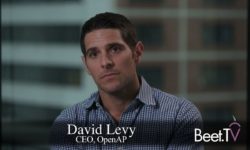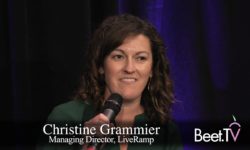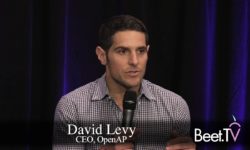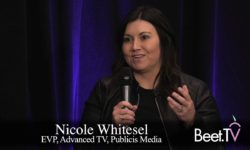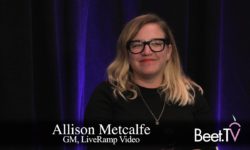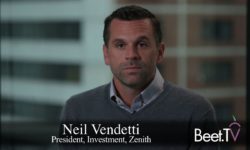Advanced TV ad targeting tactics present the promise of up-ending the traditional way in which TV ads are bought – upfront and for a mass audience – in favor of something more real-time and personalized.
But buyers need to be walked through the transition, and an ultimate conversion to 100% addressable may not be the end outcome regardless.
In a panel at Beet Retreat In The City, “What Programmers & Brands Want from Advanced TV”, three industry executives were asked why around 10% of national TV ad spend goes toward advanced TV targeting, rather than around 50%:
- A+E Networks – SVP, precision, Ethan Heftman
- LiveRamp – John Hoctor
- NBCUniversal – Dominick Vangeli
They were questioned by Janus Strategy & Insights president Howard Shimmel..
Transition is hard
A+E’s Heftman said: “The reality is, doing business outside of Nielsen age, gender demos is time consuming.”
NBCU’s Vangeli agreed: “The process of onboarding a first party data set … think about how much more complicated that is than transacting on adults (aged) 25 to 54.
“There’s a legacy business with decades and decades of a specific way to transact, and then all of a sudden all the viewership behaviour started to change and fragment.”
No race to bottom-funnel
Although connected TV and advanced targeting capabilities hold the potential to use attribution methods in order to offer performance-driven TV ads, A+E’s Heftman thinks assuming that will be the norm is a misconception.
“Sophisticated marketers at brands and at agencies have always known the value of television for upper funnel, awareness and consideration metrics,” he said. “And now we’re finally able to put lower funnel, foot traffic sales, those types of metrics against it.
“I think the fear of throwing the baby out with the bath water, the idea that we’re all just going to focus on the lower funnel value of television at the expense of the upper funnel… that’s really overblown because we’re all pretty sophisticated.”
Learn to love incomplete
LiveRamp’s Hoctor warned advertisers not to over-estimate the powers of the new medium.
“You have to go into the problem realising you’re never going to have all the data,” he said. “You have to know that out of the gate. Because you’re never going to know if your neighbour recommended the car, or something like that. That’s just not something that’s publicly available, or even privately available for you to do analytics against.
“We have to really calculate a baseline and what would have happened in the absence of the media that we’re measuring”
Context optimizes inventory
NBCU’s Vangeli detailed how NBCU is offering advertisers the ability to buy inventory adjacent to particular show moments, based on machine learning analysis of scripts and closed captions, plugged in to ad sales platforms.
“Let’s pretend a movie is starting to segue into a commercial break, and there’s a great scene where James Bond is shaving in the mirror,” he said. “And this is exactly something that we saw and we tested internally.
“Well then right after that, why is there not a Gillette ad or Dollar Shave Club ad? And so there’s a way to bring context at greater scale on a lot of the programming.”
This video was produced at the Beet Retreat leadership event hosted Publicis Media in New York. The event and video series is sponsored by FreeWheel and LiveRamp. For more videos from the event, please visit this page.






